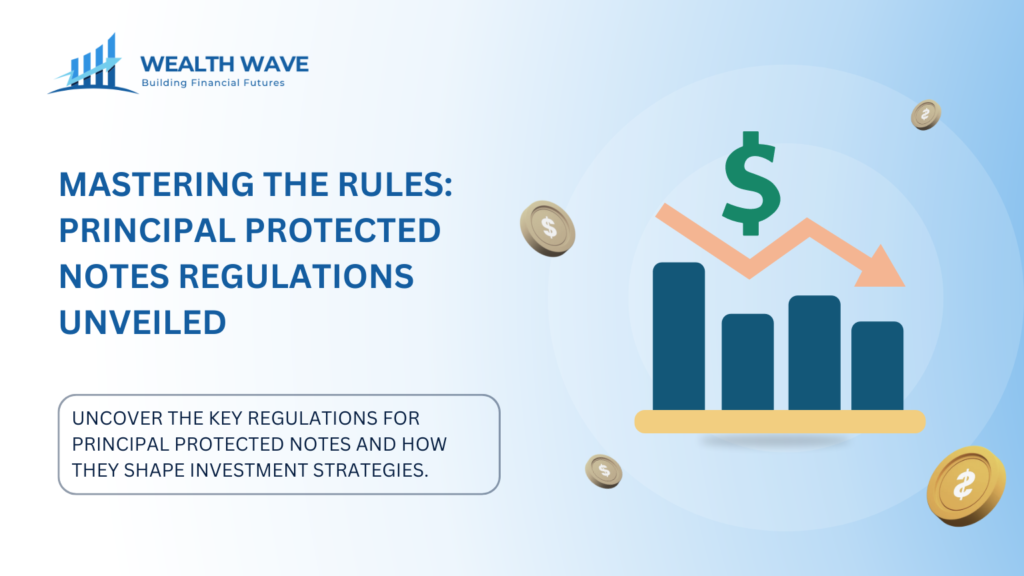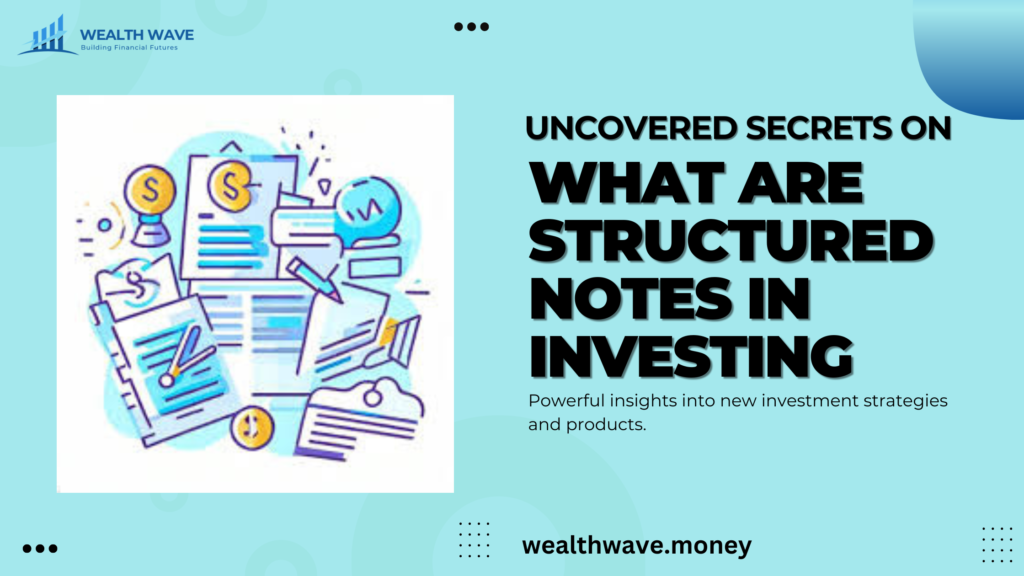Investing can sometimes feel like wandering through a labyrinth, with the sheer number of choices and risks lurking around every corner. It’s all the more daunting when you’re trying to safeguard your hard-earned cash while still eyeing a decent return.
Trust us, we’ve felt that anxiety too—fretting over our investments in the face of market unpredictability. That’s why we took a closer look at Principal Protected Notes Regulations, which seemed like a beacon of hope for those seeking security in their investment journey.
These debt products caught our attention because they promise something precious: peace of mind. Principal Protected Notes come with a bold guarantee – 100% protection of your principal amount if you hold them until maturity, provided they are backed by financial institutions that can keep this promise.
This post aims to demystify PPNs, explaining how they function, outlining their regulations, and offering insights on what you need to know before adding them to your portfolio. Think of it as making sense of complex financial derivatives for everyone.
Let’s navigate these waters together and keep your investment safe!
Key Takeaways
- Principal Protected Notes (PPNs) ensure the return of your initial investment if you keep them until maturity. They offer a blend of investment growth potential tied to market assets, with the security of capital preservation.
- Financial regulations require that institutions disclose all necessary information about PPNs before investors commit. These transparency mandates help investors understand risks, fees, and how these investments fit within their portfolios.
- PPNs come with certain risks like interest rate changes affecting returns and the possibility of zero returns if linked assets don’t perform well. Additionally, high fees associated with some PPNs can reduce overall gains.
- Investor protection is paramount in the regulatory framework governing PPNs. Regulations ensure that investors receive comprehensive details on the features and risks associated with these notes before making an investment decision.
- The suitability of PPNs varies among investors; they are especially appealing to those prioritizing safety over high returns. Understanding one’s financial goals and risk tolerance is key when considering adding PPNs to an investment portfolio.
What are Principal Protected Notes (PPNs)?
Principal Protected Notes (PPNs) are unique financial products that combine investment and protection. They promise to return the initial investment amount while offering potential growth linked to the performance of underlying assets.
When entering into the agreement for principal protected notes, it is crucial to understand the terms and conditions laid out. For instance, an advertisement gives an example of how the notes might be linked to an index or reference point, illustrating the potential returns based on that benchmark. A person who is knowledgeable about the financial instrument will be able to provide a clear example of a situation where these notes perform optimally.
Additionally, understanding knowledgeable about the terms can help in assessing the example of another scenario where the conditions might vary. Proper comprehension of these aspects ensures that investors make informed decisions and adhere to regulatory standards.
Definition and Features
Principal protected notes (PPNs) are fixed-income securities. They offer a guarantee to return all invested principal at maturity. These notes provide full principal protection, which means we will receive our initial investment back even if the market fluctuates.
Entering into an agreement for principal protected notes requires careful consideration of various factors. Fees of structured or administered may place an impact on returns, and these must be disclosed in the advertisement. The minimum interest that is guaranteed is a key term, with minimum interest being payable in addition to any minimum interest. It is used to determine the interest payable based on the index or reference point used to calculate it.
A telephone number of a person who is knowledgeable about the terms should be provided for inquiries. Ensure there is no conflict of interest and that all terms are clearly understood to avoid any issues related to the terms and conditions.
Investors often refer to them as linked notes or return notes.
We can benefit from structured notes, especially because they have gained popularity in the retail market in recent years. PPNs are appealing to those who want a secure investment.
They offer a level of security for investors concerned about recovering their initial investment. These investments work well alongside other financial products, such as CDs, which also provide 100% principal protection if held until maturity.
How They Work
Principal-protected notes (PPNs) operate as fixed-income securities. They guarantee to return, at a minimum, all invested principal. These notes provide full principal protection, which means we can invest without worrying about losing our initial amount.
When we purchase a PPN, our investment remains secure as long as we hold it to maturity. The issuing financial institution must fulfill its obligation to ensure this guarantee.
Principal protected notes function by offering a fixed rate of return, with their performance often based on the last available data or past market performance. The levels of risk and return are clearly defined in the conditions of the note. The interest payable under the note is calculated based on these conditions, and any impact on the interest payable due to changes in market conditions must be transparently disclosed. In some cases, an institution in a conflict of interest may affect the terms, so it’s essential that examples must be realistic and clearly illustrate how the notes perform in different scenarios. Understanding these elements ensures investors make informed decisions.
Their 100% principal protection appeals to many investors, allowing us to engage with the market confidently.
Potential Scenarios
Principal protected notes (PPNs) offer several potential scenarios for investors. In one scenario, we invest in a PPN that guarantees a minimum return while linking to the performance of stocks or other assets.
If the market performs well, we can benefit from higher returns. In another scenario, we hold the PPN until maturity. This ensures that we receive 100 percent of our invested principal back, regardless of market conditions.
PPNs serve as a valuable option for those of us seeking capital preservation. By choosing these fixed-income securities, we protect our initial investment while still having the potential for growth.
Understanding these scenarios helps us make informed decisions about incorporating PPNs into our portfolios.
How Do These Notes Protect My Investment?
Principal Protected Notes guarantee a return on our investment. They help us preserve our capital while managing risk effectively.
Principal protected notes are designed to provide that the principal amount invested is safeguarded, ensuring that you will not receive less than the principal amount at maturity. However, it’s important to note that a protected note does not include protection against all possible losses, and in some cases, you might receive less than the principal amount if specific conditions aren’t met.
To fully understand how these notes work, you should obtain information about the notes from the issuing institution. The agreement for the issuance will detail how the principal amount that the institution guarantees is protected. The note specifies that the interest can be a fixed rate of interest or a variable rate of interest, and these rates may differ based on market conditions and the terms of the note. Always ensure you review the details to understand how the note relates to deposits and the specific conditions that apply.
Guarantee of Return
Principal-protected notes (PPNs) offer a guarantee of return on our investment. We know that these fixed-income securities promise to return at least the full amount of our invested principal.
This means if we hold our PPNs until maturity, we will receive our initial investment back, provided the issuer meets its obligations. PPNs provide a sense of security for those of us concerned about losing our initial capital.
These notes have gained popularity among retail investors in recent years. They serve as a safety net for our investments, allowing us to benefit from potential market growth while ensuring our principal remains protected.
Understanding this guarantee gives us confidence in our investment decisions.
Capital Preservation
Capital preservation plays a vital role in the appeal of principal-protected notes (PPNs). These fixed-income securities guarantee, at a minimum, the return of our invested principal.
Investors like us appreciate that PPNs offer 100% principal protection, reassuring us about the safety of our capital. With PPNs, we can maintain our initial investment, provided we hold them to maturity and the issuer fulfills their obligation.
This unique feature allows us to manage risk effectively. The added layer of security suits our needs, especially when we worry about potential losses in the market. By understanding how capital preservation works in PPNs, we can make informed choices for our investment portfolios.
Risk Management
Understanding risk management helps us make informed choices about principal-protected notes (PPNs). These fixed-income securities guarantee the return of our invested principal. They provide a sense of security for us, especially if we are concerned about losing our initial investment.
While PPNs offer 100% principal protection if held to maturity, we should consider potential risks. Interest rate risk can affect returns. If interest rates rise, our PPNs might not keep pace with other investments.
Zero-return risk also exists, meaning we could end up with no income if the linked assets do not perform well. We must also be aware of fee risks, as high fees can cut into our returns.
Understanding these factors is essential for effective risk management in our investment strategies.
Disclosure Requirements
Disclosure requirements play a crucial role in protecting investors. They ensure that financial institutions provide clear information about PPNs. This information helps us make informed decisions.
Transparency is vital for our understanding of risks and benefits. We encourage you to explore this topic further to grasp its importance completely.
Financial Regulations
Financial regulations play a crucial role in the sale and marketing of principal-protected notes (PPNs). Federally regulated financial institutions must disclose specific information to investors before they enter into agreements regarding PPNs.
These regulations aim to protect investor rights and ensure transparency about the product’s features and risks.
There is no single body of regulations governing the issuance and sale of PPNs. Instead, multiple financial regulations apply, which can vary widely. Understanding these regulations allows us to make informed decisions about investment suitability.
As we navigate the landscape of fixed-income securities, we should prioritize our awareness of how these regulations affect our investments.
Investor Protection
Investor protection plays a crucial role in the world of principal protected notes (PPNs). We must ensure that investors have access to vital information before entering agreements.
Federally regulated financial institutions must disclose specific details about PPNs. This transparency helps us understand the nature of these fixed-income securities.
We find comfort in knowing PPNs offer 100% principal protection if held to maturity. This feature appeals to those concerned about the return of their initial investment. By learning about the regulations surrounding PPNs, we can make informed decisions.
Understanding risks and fees also enhances our investment strategies. Ultimately, thorough investor protection measures strengthen our confidence in the market.
Suitability for Investors
We focus on understanding the suitability of principal-protected notes (PPNs) for different investors. PPNs are fixed-income securities that guarantee the return of all invested principal, making them attractive for those who prioritize safety.
They provide 100 percent principal protection, which appeals to conservative investors.
Investors seeking steady returns can find value in PPNs. These notes often offer a minimum return guarantee, enhancing their appeal for those concerned about capital preservation. Financially regulated institutions must disclose crucial information about these investments, helping us make informed decisions.
Understanding the risks and fees associated with PPNs further ensures that we choose suitable investments tailored to our financial goals.
Potential Risks and Fees
Investors should prepare for certain risks and fees associated with principal protected notes. Interest rate changes can impact returns, and there is a chance of receiving no return at all in some situations.
Interest Rate Risk
Interest rate risk poses challenges for principal protected notes (PPNs). As interest rates rise, the value of these fixed-income securities can fall. This occurs because new bonds usually pay higher returns, making older, lower-yielding PPNs less attractive.
Although PPNs guarantee full principal protection if held to maturity, we must recognize that market fluctuations may impact their market value before maturity.
We understand that zero-return risk also exists in this context. If interest rates remain low or decrease, our return on investment may be limited. We should stay informed about how interest rates affect our fixed-income investments and be aware of the potential risks involved.
Zero-Return Risk
Zero-return risk presents a challenge for us as investors in principal-protected notes (PPNs). While PPNs guarantee 100 percent principal protection, the potential for zero returns exists if market conditions do not favor growth.
This situation arises when the linked assets do not perform well enough to generate any interest or returns at maturity. We must remember that although we secure our initial investment, we might miss out on any additional gains.
PPNs provide security for our capital, but achieving a guaranteed return is not always certain. The design of these fixed-income securities means that we could end up with just our original investment back.
Understanding zero-return risk is essential for those of us considering PPNs. Assessing our risk tolerance can help us navigate the potential outcomes of this investment strategy.
Fee Risk
Fee risk can significantly impact our returns on principal protected notes (PPNs). While these investments offer 100% principal protection, fees can reduce our overall gains. Some PPNs may come with high management or transaction fees.
If we aren’t careful, these costs can erode our expected returns.
Investing in these fixed-income securities requires us to understand the fee structure clearly. Federally regulated financial institutions must provide disclosure about these fees before we make any agreements.
Knowing the fee risks helps us make informed decisions about our investment strategies with principal protected notes.
Conclusion
Understanding the regulations surrounding Principal Protected Notes (PPNs) is not just beneficial—it’s essential for making informed investment decisions. By grasping the regulatory framework, we can better assess the security, risks, and potential returns associated with PPNs. Furthermore, staying informed about regulatory updates and industry practices is crucial as the financial landscape continues to evolve. Regulations can change, impacting the protection and performance of PPNs. By maintaining an active approach to education and regularly consulting trusted resources, we can adapt our investment strategies to reflect the most current information. This proactive mindset not only safeguards our investments but also empowers us to take full advantage of the opportunities PPNs offer while minimizing potential risks.
FAQs
Q1. What are principal protected notes regulations?
Ans. Principal protected notes regulations refer to the rules governing fixed-income securities that offer a percentage of principal protection.
Q2. How do SOR regulations impact fixed-income securities?
Ans. SOR regulations can influence the structure and operations of fixed-income securities, including those with principal protection features.
Q3. Can you explain what a fixed-income security is?
Ans. A fixed-income security is an investment tool that provides regular income payments and offers return of the initial investment or "principal" at maturity.
Q4. Are all fixed-income securities under SOR regulations offering % principal protection?
Ans. Not all, but some types of these investments may provide a certain degree of principal protection as per SOR regulations requirements.




